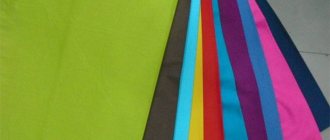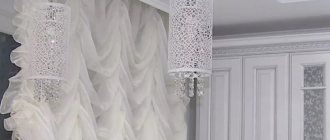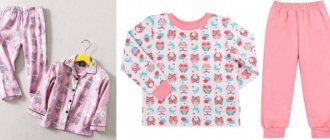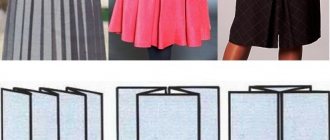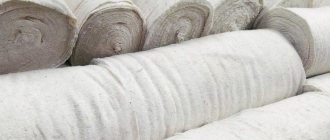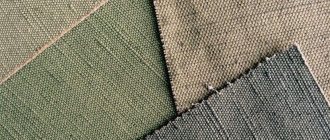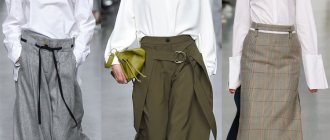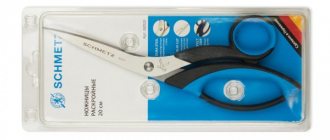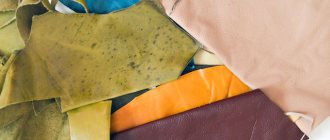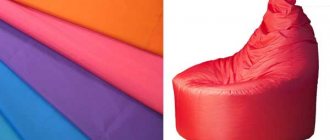The thin, sheer fabric combines oriental charm with a slightly tantalizing western edge. It drapes beautifully, is easy to wear and does not hinder movement. Products made from thin transparent fabrics look very elegant and are suitable for women regardless of body size and age.
These fabrics are very mobile, so before you start working with them, you need to lay a thin cotton fabric on the work surface.
Popular types of transparent fabrics
- Chiffon. The highlight of the material is the “sandy” texture of the surface, which is achieved through a cross-shaped weave of threads. There are pure chiffon (made from natural silk fibers) and combined (crepe chiffon, chiffon jacquard, shanzhan, etc.). In combined fabrics, silk fibers are intertwined with cotton or synthetic fibers.
Sandy texture of chiffon
- Batiste. Unlike chiffon, this fabric has a perfectly smooth texture. It is made from twisted cotton or flax fibers. The warp and weft threads are equal in thickness, so despite all its transparency, the material is also quite durable.
Multi-colored cambric
- Veil. Cotton or synthetic fabric with plain weave fibers and a smooth surface. One of the thinnest and lightest transparent materials. Due to the weak interweaving of the fibers, it resembles a mesh.
Voile is one of the lightest transparent fabrics
- Gas. Another ultra-light fabric with a smooth texture. It is distinguished by a special gas weave: 2 warp threads to 1 weft thread. It is made from raw silk or mixed fibers (silk + cotton).
Gauze weave material
- Organza. Lightweight, shiny polyester fabric. It is used mainly for sewing wedding dresses and curtains.
Shiny organza surface
Classification
Below we will look at the main types of thin fabrics that are relevant today. Some of them are made these days from both natural and man-made fibers.
Batiste
Very thin, almost transparent linen (less often cotton) fabric with a plain weave. As, indeed, with most similar lightweight materials, its homeland is India. The cambric lays down in soft, airy folds. Its name comes from the name of François Baptiste, a French weaver who recreated it in Europe in the 14th century.
In the era of the musketeers, men wore snow-white cambric shirts, beautifully trimmed with lace. Today this material is used mainly for sewing blouses, as well as all kinds of summer and simply elegant clothes.
Marquisette
This is a light and thin, almost transparent and predominantly cotton fabric made from twisted yarn (very thin). Its name comes from "marquisette" - a French word for the external awning of a marquise window, which is used to protect from sunlight and was originally made from paper fabric.
The material drapes remarkably well, has excellent breathability, is easy to wash and iron. This cotton fabric is great for making blouses and other summer clothes. To visualize the voile, it is enough to recall the feminine dresses of women of the 30s with puff sleeves and elongated flared skirts.
Veil
This is a sparsely woven, most transparent, predominantly cotton (less often wool or silk) fabric. It is characterized by a plain weave, and in appearance it looks like thick gauze. The name of this material comes from a long veil, which was part of women's toilets, and was intended to cover women's faces and bodies. Such a veil (mostly black) is called a “burqa” in eastern countries.
Products made from a veil must be washed extremely carefully, avoiding large mechanical loads. The veil is perfectly ironed, perfectly breathable, so it is simply irreplaceable for the summer season.
Chintz
It is a lightweight cotton fabric of plain weave, often with a bright printed pattern. Since ancient times, chintz with colorful floral patterns has been used for sewing Russian folk clothing (shirts, sundresses, etc.). Its name has come to us in such a form that it is difficult to immediately establish its original source.
Thus, the Dutch changed the Bengali name for variegated cotton fabric “chits” (English - “chints”) to “sits”, and in our country the material began to be called chintz.
The disadvantages of this cotton fabric are low strength and insufficient color fastness. These problems are partially eliminated by finishing. As for the main advantages of such cotton fabric, they include lightness, good breathability, and relatively low cost. Chintz washes perfectly, dries quickly and is easy to iron. Items made from chintz are perfect for summer, including children's clothing.
Gas
Gas is probably the lightest, most transparent matter with a special gas weave. Thanks to the space between the threads, this fabric is soft and translucent.
According to one version, its name comes from the city of Gaza, where it was first made.
According to another opinion (Vasmer's etymological dictionary), the name refers to the French word "gaze", which in turn reflects the Arabic word for "raw silk". In the second half of the 19th century, gauze dresses with a satin or satin cover were in fashion. Nowadays, gas is used for decoration and is mainly popular in wedding decorations.
Chiffon
Thin transparent cotton or silk fabric with plain weave of high density. Due to this, the material has a large weight, which allows the formation of plastic folds.
During the Art Nouveau era, chiffon was very popular, although the origin of its name remains a mystery. Refined ladies of that time preferred chiffon blouses with very puffy and gathered sleeves.
Today, chiffon is made mainly from synthetic fibers. This fabric does not wrinkle and is perfect for sewing elegant blouses decorated with various flounces and ruffles.
Georgette
Georgette (another name is “crepe-georgette”) is a translucent silk crepe that has a matte, slightly grainy texture to the touch. Georgette is quite elastic and drapes beautifully. This fabric looks elegant and noble, and it has also been extremely popular lately. It is used to make blouses, skirts and dresses, and suits.
Organza
This is a thin, rigid, transparent silk fabric obtained as a result of finely patterned weaving. Unfortunately, the origin of its name is not known for certain. Organza has a matte texture and is somewhat reminiscent of a slightly shiny layer of the finest ice. Although it is found not only in white, but also in other colors. It is often used for collars and other trims, and because of its stiffness and transparency, the fabric is used for formal wear. For example, dark, glossy organza can be suitable for sewing an evening dress or even luxurious curtains.
Features of working with transparent fabrics
| Problem | Solution |
| When cutting, the material slides | Cut the material on a non-slip surface: plywood, cardboard, etc. |
| When marking with a pencil, the lines are visible from the front side of the fabric. | Use a special disappearing marker to mark the fabric. The contours will completely disappear in 6-8 days (faster if you soak the product in warm water). IMPORTANT: Do not iron the fabric until the marking contours are completely dissolved. Otherwise, the lines will be “imprinted” into the material and it will be much more difficult to remove them. Individual marks can be made in the form of notches on seam allowances |
| When ironing, the fabric melts or shrinks | Iron transparent fabrics only in the "chemical fiber/silk" mode without steaming. Make sure there is no carbon deposits on the soleplate of the iron. To be sure, it is better to iron transparent materials through a tissue paper pad. |
Advantages and disadvantages
Advantages of gas:
- hypoallergenic,
- antibacterial: bacteria do not multiply on its surface;
- breathability;
- lightness: even multi-layered outfits turn out weightless;
- retains its appearance for a long time (subject to proper care);
- goes well with other, denser fabrics;
- ease of care.
Flaws:
- low strength;
- clues appear easily;
- difficult to cut and requires professional skills to work with it.
Which seams are suitable for transparent fabrics?
- A simple seam with overlock seams. The length of the allowances should not exceed 5–7 mm. Such seams are not suitable for tight-fitting items: the stitching will show through.
- Covering seam with “sealed” seam allowances. It is carried out in two stages. Place the patterns right sides together, stitch and iron in one direction. Then cut the bottom seam allowance to a width of 5 mm, wrap it around the top seam and stitch along the edge to the main fabric. You will get a thin, neat scar. To make such a seam, make allowances of at least 15 mm.
- French double seam. Sew the patterns right sides together. Iron the seam allowances and cut to a height of 10–12 mm. Then fold their edges towards the seam, fold them together and stitch.
Double French seam: view from the front and back sides
Bottom processing options
| Product type | Processing method |
| Pleated outfits | Processing with bias tape |
| Tight-fitting clothing with straight bottom | Zigzag stitch using monofilament thread |
| Flowy clothes with wide bottoms | Narrow hem |
What standards are used in production? What do they take into account?
In the manufacture of silk fabrics, incl. and gas, the standards prescribed in GOST 28253-89 are used: “Silk and semi-silk dress and dress-costume fabrics. General technical conditions". Namely:
- The color fastness of the fabric must comply with GOST 7779;
- in terms of artistic and aesthetic indicators, fabrics must correspond to standard samples approved in accordance with GOST 15.007;
- abrasion resistance - according to GOST 18976;
- crease resistance - according to GOST 19204;
- resistance to crumbling - according to GOST 3814;
- hygroscopicity - according to GOST 3816.
How to work with delicate fabrics
Transparent fabrics are unusually thin. This needs to be taken into account. When working with them, you must adhere to certain rules.
It is very common for light, thin fabric to slip out while sewing. To avoid this, you need to lay cotton or other natural fabric on the table surface.
Notes
Marks with tailor's chalk or markers on these fabrics are clearly visible from the front side of the fabric. Their appearance spoils the sewn item. Therefore, the lines should be made with long stitches using a thin thread. It can be removed after grinding the parts.
Needles
You need to work with the canvas using only very thin and long needles. Machine seams are made with 70-80 mm needles. You can also use special needles for thin fabrics.
Undercuts
When sewing things from such fabrics, they try not to use undercuts. Draperies and folds are used together. The facings and hems of the edges of the item are folded 2 times. This way the cut will not be visible.
Stitches
The length of the machine stitch is 0.2 cm. There is no need to stitch across the pins when sewing on the machine. Otherwise, you can cause severe tension. It will lead to flaws. To improve progress, it is worth placing paper under the fabric.
Wide seams worsen the appearance of the item, and thin seams are not strong. If a double seam is used to sew elements together, then the first seam is made “outside”. In this case, the elements are folded with the wrong sides, and the second seam is made “inside”. He hides the first seam inside himself.
Processing slices
Processing the cut of a ruffle or flounce is done with a double seam in the hem with a closed cut (it is called the “Moscow seam”) or a rolled seam. Processing with oblique satin ribbon and edging is also used.
Note! Seam cuts on the shoulders and sides should be done as carefully as possible. Thin, even cuts processed using an overlocker look great, but if there is no overlocker, then processing with a closed seam and a French seam is used.
For what purposes can it be used?
Gas fabrics are used for sewing:
Summer and elegant clothes: blouses, multi-layered or lined dresses, skirts
Wedding dresses, veils
Theatrical and carnival costumes, ballet tutus
Garment finishing: ruffles, flounces, bows
Accessories: shawls, scarves, headscarves, stoles, decorations in the form of flowers
Curtains, curtains, bed curtains
This material is often used to decorate banquet halls and restaurant terraces.
